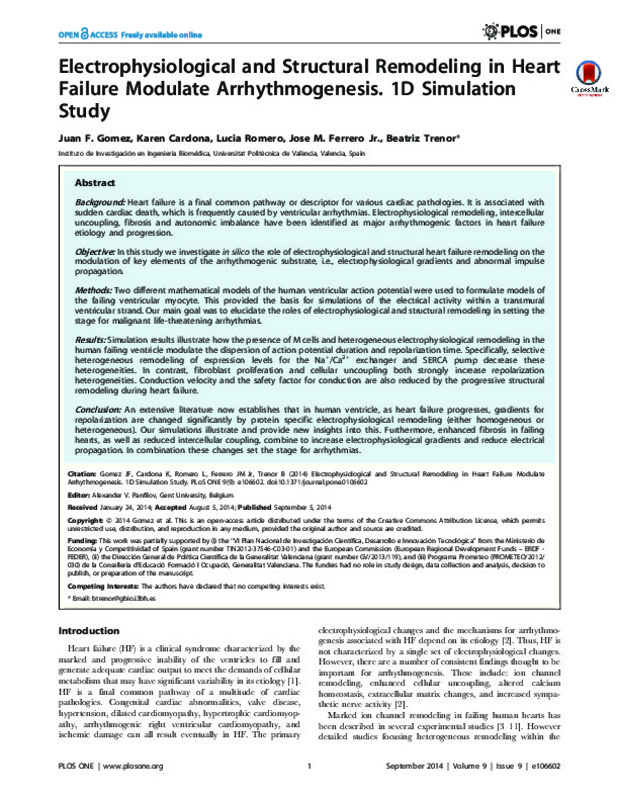JavaScript is disabled for your browser. Some features of this site may not work without it.
Buscar en RiuNet
Listar
Mi cuenta
Estadísticas
Ayuda RiuNet
Admin. UPV
Electrophysiological and Structural Remodeling in Heart Failure Modulate Arrhythmogenesis. 1D Simulation Study
Mostrar el registro sencillo del ítem
Ficheros en el ítem
| dc.contributor.author | Gómez García, Juan Francisco
|
es_ES |
| dc.contributor.author | Cardona, Karen
|
es_ES |
| dc.contributor.author | Romero Pérez, Lucia
|
es_ES |
| dc.contributor.author | Ferrero De Loma-Osorio, José María
|
es_ES |
| dc.contributor.author | Trénor Gomis, Beatriz Ana
|
|
| dc.date.accessioned | 2015-07-08T12:11:45Z | |
| dc.date.available | 2015-07-08T12:11:45Z | |
| dc.date.issued | 2014-09-05 | |
| dc.identifier.issn | 1932-6203 | |
| dc.identifier.uri | http://hdl.handle.net/10251/52835 | |
| dc.description.abstract | Background: Heart failure is a final common pathway or descriptor for various cardiac pathologies. It is associated with sudden cardiac death, which is frequently caused by ventricular arrhythmias. Electrophysiological remodeling, intercellular uncoupling, fibrosis and autonomic imbalance have been identified as major arrhythmogenic factors in heart failure etiology and progression. Objective: In this study we investigate in silico the role of electrophysiological and structural heart failure remodeling on the modulation of key elements of the arrhythmogenic substrate, i.e., electrophysiological gradients and abnormal impulse propagation. Methods: Two different mathematical models of the human ventricular action potential were used to formulate models of the failing ventricular myocyte. This provided the basis for simulations of the electrical activity within a transmural ventricular strand. Our main goal was to elucidate the roles of electrophysiological and structural remodeling in setting the stage for malignant life-threatening arrhythmias. Results: Simulation results illustrate how the presence of M cells and heterogeneous electrophysiological remodeling in the human failing ventricle modulate the dispersion of action potential duration and repolarization time. Specifically, selective heterogeneous remodeling of expression levels for the Na+ /Ca2+ exchanger and SERCA pump decrease these heterogeneities. In contrast, fibroblast proliferation and cellular uncoupling both strongly increase repolarization heterogeneities. Conduction velocity and the safety factor for conduction are also reduced by the progressive structural remodeling during heart failure. Conclusion: An extensive literature now establishes that in human ventricle, as heart failure progresses, gradients for repolarization are changed significantly by protein specific electrophysiological remodeling (either homogeneous or heterogeneous). Our simulations illustrate and provide new insights into this. Furthermore, enhanced fibrosis in failing hearts, as well as reduced intercellular coupling, combine to increase electrophysiological gradients and reduce electrical propagation. In combination these changes set the stage for arrhythmias. | es_ES |
| dc.description.sponsorship | This work was partially supported by (i) the "VI Plan Nacional de Investigacion Cientifica, Desarrollo e Innovacion Tecnologica" from the Ministerio de Economia y Competitividad of Spain (grant number TIN2012-37546-C03-01) and the European Commission (European Regional Development Funds - ERDF - FEDER), (ii) the Direccion General de Politica Cientifica de la Generalitat Valenciana (grant number GV/2013/119), and (iii) Programa Prometeo (PROMETEO/2012/030) de la Conselleria d'Educacio Formacio I Ocupacio, Generalitat Valenciana. The funders had no role in study design, data collection and analysis, decision to publish, or preparation of the manuscript. | en_EN |
| dc.language | Inglés | es_ES |
| dc.publisher | Public Library of Science | es_ES |
| dc.relation.ispartof | PLoS ONE | es_ES |
| dc.rights | Reconocimiento (by) | es_ES |
| dc.subject | Heart Failure | es_ES |
| dc.subject | Electrophysiological and Structural Remodeling | es_ES |
| dc.subject | Computer modelling | es_ES |
| dc.subject.classification | TECNOLOGIA ELECTRONICA | es_ES |
| dc.title | Electrophysiological and Structural Remodeling in Heart Failure Modulate Arrhythmogenesis. 1D Simulation Study | es_ES |
| dc.type | Artículo | es_ES |
| dc.identifier.doi | 10.1371/journal.pone.0106602 | |
| dc.relation.projectID | info:eu-repo/grantAgreement/MINECO//TIN2012-37546-C03-01/ES/CORAZON HUMANO COMPLETO FISIOLOGICO VIRTUAL: MEJORAS EN EL TRATAMIENTO DE ARRITMIAS CARDIACAS ORIENTADO A PACIENTE/ | es_ES |
| dc.relation.projectID | info:eu-repo/grantAgreement/GVA//GV%2F2013%2F119/ | es_ES |
| dc.relation.projectID | info:eu-repo/grantAgreement/GVA//PROMETEO%2F2012%2F030/ES/MEJORA EN LA PREVENCION Y TRATAMIENTO DE PATOLOGIAS CARDIACAS A TRAVES DE LA MODELIZACION MULTI-ESCALA Y LA SIMULACION COMPUTACIONAL (DIGITAL HEART)/ | es_ES |
| dc.rights.accessRights | Abierto | es_ES |
| dc.contributor.affiliation | Universitat Politècnica de València. Instituto Interuniversitario de Investigación en Bioingeniería y Tecnología Orientada al Ser Humano - Institut Interuniversitari d'Investigació en Bioenginyeria i Tecnologia Orientada a l'Ésser Humà | es_ES |
| dc.contributor.affiliation | Universitat Politècnica de València. Departamento de Ingeniería Electrónica - Departament d'Enginyeria Electrònica | es_ES |
| dc.description.bibliographicCitation | Gómez García, JF.; Cardona, K.; Romero Pérez, L.; Ferrero De Loma-Osorio, JM.; Trénor Gomis, BA. (2014). Electrophysiological and Structural Remodeling in Heart Failure Modulate Arrhythmogenesis. 1D Simulation Study. PLoS ONE. 9(9). https://doi.org/10.1371/journal.pone.0106602 | es_ES |
| dc.description.accrualMethod | S | es_ES |
| dc.relation.publisherversion | http://dx.doi.org/10.1371/journal.pone.0106602 | es_ES |
| dc.type.version | info:eu-repo/semantics/publishedVersion | es_ES |
| dc.description.volume | 9 | es_ES |
| dc.description.issue | 9 | es_ES |
| dc.relation.senia | 276147 | |
| dc.identifier.eissn | 1932-6203 | |
| dc.identifier.pmid | 25191998 | en_EN |
| dc.identifier.pmcid | PMC4156355 | en_EN |
| dc.contributor.funder | Generalitat Valenciana | es_ES |
| dc.contributor.funder | Ministerio de Economía y Competitividad | es_ES |
| dc.contributor.funder | European Regional Development Fund | es_ES |








